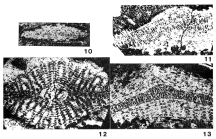Foraminifera taxon details
Historbitoides Brönnimann, 1956 †
722370 (urn:lsid:marinespecies.org:taxname:722370)
accepted
Genus
Historbitoides kozaryi Brönnimann, 1956 † (type by original designation)
marine, brackish, fresh, terrestrial
fossil only
masculine
Brönnimann, P. (1956). Upper Cretaeeous orbitoidal Foraminifera from Cuba. Part V. Historbitoides, n.
gen. <em>Contributions from the Cushman Foundation for Foraminiferal Research.</em> 6: 60-66.
page(s): p. 61 [details]
page(s): p. 61 [details]
Hayward, B.W.; Le Coze, F.; Vachard, D.; Gross, O. (2024). World Foraminifera Database. Historbitoides Brönnimann, 1956 †. Accessed at: https://marinespecies.org/foraminifera/aphia.php?p=taxdetails&id=722370 on 2024-04-23
Date
action
by
original description
Brönnimann, P. (1956). Upper Cretaeeous orbitoidal Foraminifera from Cuba. Part V. Historbitoides, n.
gen. <em>Contributions from the Cushman Foundation for Foraminiferal Research.</em> 6: 60-66.
page(s): p. 61 [details]
basis of record Loeblich, A. R.; Tappan, H. (1987). Foraminiferal Genera and their Classification. Van Nostrand Reinhold Company, New York. 970pp., available online at https://books.google.pt/books?id=n_BqCQAAQBAJ [details] Available for editors [request]
[request]
page(s): p. 61 [details]
basis of record Loeblich, A. R.; Tappan, H. (1987). Foraminiferal Genera and their Classification. Van Nostrand Reinhold Company, New York. 970pp., available online at https://books.google.pt/books?id=n_BqCQAAQBAJ [details] Available for editors
From editor or global species database
Diagnosis Test lenticular in megalospheric generation and up to 1.6 mm in diameter, more discoidal microspheric test up to 4 mm, juvenarium quadriserial and symmetrical, single equatorial layer of chambers has interconnected irregular vertical radial plates, differentiated radii and interradii result in a weakly stellate structure, radii have vertical radial plate's perpendicular to the axis of the radii, whereas in the interradii the plates intersect the equatorial layer and fuse to form a discontinuous floor, stellate appearance masked at the surface by lateral layers of chambers on both sides, primary lateral chambers directly overlying the equatorial layer and in turn overlain by regular tiers of secondary lateral chambers in a lenticular thickening, lateral chambers interconnected by basal stolons and fine pores, pillars regularly distributed. U. Cretaceous (Maastrichtian); Cuba. (Loeblich & Tappan, 1987, Foraminiferal Genera and Their Classification) [details]
